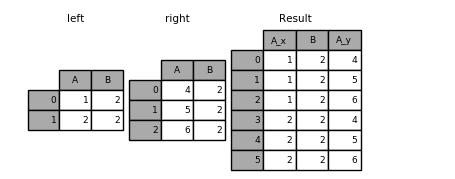小编给大家分享一下pandas怎么使用merge实现百倍加速的操作,希望大家阅读完这篇文章之后都有所收获,下面让我们一起去探讨吧!一个非常直接的实现方法:先生成一串目标时间序列,从某个开始日到今天为止,每七天一个日期。把这些日期map到数据
小编给大家分享一下pandas怎么使用merge实现百倍加速的操作,希望大家阅读完这篇文章之后都有所收获,下面让我们一起去探讨吧!
先生成一串目标时间序列,从某个开始日到今天为止,每七天一个日期。
把这些日期map到数据集的日期, Eg. {“2019-06-18”:“2019-06-15”…} 。
把map到的数据抽出来用pd.concat接起来。
target_dates = pd.date_range(end=now, periods=100, freq="7D")full_dates = pd.date_range(start, now).tolist()org_dates = df.date.tolist()last_date = Nonefor d in full_dates: if d in org_dates: date_map[d] = d last_date = d elif last_date is not None: date_map[d] = last_date else: continuenew_df = pd.DataFrame()for td in target_dates: new_df = pd.concat([new_df, df[df["date"]==date_map[td]])这样的一个算法处理一个接近千万量级的数据集上大概需要十多分钟。仔细检查发现,每一次合并的dataframe数据量并不小,而且总的操作次数达到上万次。
所以就想如何避免高频次地使用pd.concat去合并dataframe。
最终想到了一个巧妙的方法,只需要修改一下前面的第三步,把日期的map转换成dataframe,然后和原始数据集做merge操作就可以了。
target_dates = pd.date_range(end=now, periods=100, freq="7D")full_dates = pd.date_range(start, now).tolist()org_dates = df.date.tolist()last_date = Nonefor d in full_dates: if d in org_dates: date_map[d] = d last_date = d elif last_date is not None: date_map[d] = last_date else: continue #### main change is from here #####date_map_list = []for td in target_dates: date_map_list.append({"target_date":td, "org_date":date_map[td]}) date_map_df = pd.DataFrame(date_map_list)new_df = date_map_df.merge(df, left_on=["org_date"], right_on=["date"], how="inner")改进之后,所有的循环操作都在一个微数量级上,最后一个merge操作得到了所有有用的数据,运行时间在5秒左右,大大提升了性能。
补充:Pandas DataFrames 中 merge 合并的坑点(出现重复连接键)
left = pd.DataFrame({'A': [1, 2], 'B': [2, 2]})
right = pd.DataFrame({'A': [4, 5, 6], 'B': [2, 2, 2]})
result = pd.merge(left, right, on='B', how='outer')
警告:在重复键上加入/合并可能导致返回的帧是行维度的乘法,这可能导致内存溢出。在加入大型DataFrame之前,重复值。

检查重复键
如果知道右侧的重复项DataFrame但希望确保左侧DataFrame中没有重复项,则可以使用该 validate='one_to_many'参数,这不会引发异常。
pd.merge(left, right, on='B', how='outer', validate="one_to_many") # 打印的结果: A_x B A_y0 1 1 NaN1 2 2 4.02 2 2 5.03 2 2 6.0参数:
validate : str, optionalIf specified, checks if merge is of specified type.“one_to_one” or “1:1”: check if merge keys are unique in both left and right datasets.“one_to_many” or “1:m”: check if merge keys are unique in left dataset.“many_to_one” or “m:1”: check if merge keys are unique in right dataset.“many_to_many” or “m:m”: allowed, but does not result in checks.看完了这篇文章,相信你对“pandas怎么使用merge实现百倍加速的操作”有了一定的了解,如果想了解更多相关知识,欢迎关注编程网精选频道,感谢各位的阅读!
--结束END--
本文标题: pandas怎么使用merge实现百倍加速的操作
本文链接: https://lsjlt.com/news/270060.html(转载时请注明来源链接)
有问题或投稿请发送至: 邮箱/279061341@qq.com QQ/279061341
2024-05-24
2024-05-24
2024-05-24
2024-05-24
2024-05-24
2024-05-24
2024-05-24
2024-05-24
2024-05-24
2024-05-24
回答
回答
回答
回答
回答
回答
回答
回答
回答
回答
0